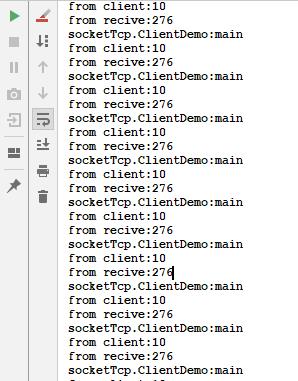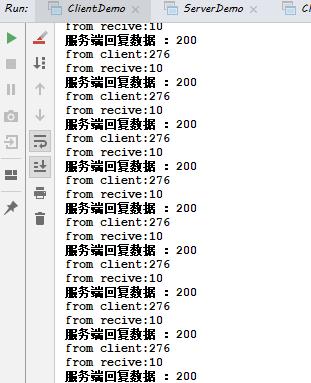手写一个模块化的 TCP 服务端客户端
Posted 牛有肉
tags:
篇首语:本文由小常识网(cha138.com)小编为大家整理,主要介绍了手写一个模块化的 TCP 服务端客户端相关的知识,希望对你有一定的参考价值。

前面的博客 基于 socket 手写一个 TCP 服务端及客户端 写过一个简单的 TCP 服务端客户端,没有对代码结构进行任何设计,仅仅是实现了相关功能,用于加深对 socket 编程的认识。
这次我们对整个代码结构进行一下优化,使其模块化,易扩展,成为一个简单意义上的“框架”。
对于 Socket 编程这类所需知识偏底层的情况(OS 协议栈的运作机制,TCP 协议的理解,多线程的理解,BIO/NIO 的理解,阻塞函数的运作原理甚至是更底层处理器的中断、网卡等外设与内核的交互、核心态与内核态的切换等),虽然说底层提供的系统函数或 JDK 封装好的原生函数帮助我们屏蔽了一大部分底层的实现细节,但如果对底层的机制没有清楚的认识,这些函数往往很难上手,始终觉着“隔着一层”。
在遇到这种情况时,应当先将函数依赖的底层运作机制搞清楚,上手实现功能,用熟 API 后再考虑代码结构的优化。毕竟代码结构的优化需要我们能清楚的找出代码中可以复用的部分,以及会出现条件分支的地方。可复用的抽取、需要分支的解耦,将代码模块化,可拔插,同时为代码留下扩展的余地。抽象化和结构化是对功能有整体的把控后才可以去做的工作。
说的有点多我们先来看些优化后的代码如何使用。
首先是服务端的构建:
public static void main(String[] args) { Server server = ServerFactory.getServer(80, SocketType.BIO, DelimitType.LengthFlag, DelimitType.LengthFlag, (socket, bytes) -> {
//bytes 是接收到的数据,在这里拿到后做业务处理。socket是本次连接的socket对象,如果对连接有特殊需求比如设置长连接短连接等可自行通过socket对象设置。
//return 的 msg 会回复给请求方
return msg; }); server.start(); }
构建服务端只需要选择监听端口、IO模式、发送数据的方式、接收数据的方式,并传入处理业务的 lamda 函数对象即可。lamda 函数对象中,我们 return 的值会被返回给请求方,如果不需要返回数据,return null 即可。
对于 IO 模式提供 BIO 与 NIO 两种模式,即传统的阻塞 IO 或 多路复用 IO。两种模式均实现了 Server 接口,可由 ServerFactory.getServer 方法进行构建。
对于 DelimitType ,数据接收和发送类型,提供了三种方式:1、DelimitType.FixedLength,定长的 TCP 报文帧;2:DelimitType.Flag,以固定分隔符进行定界的报文;3:DelimitType.LengthFlag,由报文头标识本次报文内容长度的报文定界方式。由于服务端实例接收和发送报文时存在这三种情况,我们将其封装为行为策略,与服务端实例解耦。这样我们可以根据需要选择不同的策略来构建服务端,同时如果需要新增报文定界的处理方式,只需新增一个策略类型即可。
以 BIO 中的 报文头标识长度的定界策略为例,接口:
/** * @Author Nxy * @Date 2020/3/21 20:11 * @Description 读取 接收缓冲区 接收数据行为策略 */ public interface ReciveRegister { public byte[] read(InputStream in) throws IOException; }
DelimitType.LengthFlag 策略实现类:
/** * @Author Nxy * @Date 2020/3/21 20:25 * @Description 按长度标识读取报文的读取策略。每次报文头四个字节标识本次 * 请求的报文长度,用于划定请求边界 */ public class LengthFlagReciveRegister implements ReciveRegister { @Override public byte[] read(InputStream in) throws IOException { if (in == null) { throw new NullPointerException("inputStream is null!"); } BufferedInputStream bufferIn = new BufferedInputStream(in); byte[] result; //读取头四个字节,转换为 int 即为报文长度 byte[] lengthByte = IOUtil.readBytesFromInputStream(bufferIn, 4); int length = ByteBuffer.wrap(lengthByte).getInt(); System.out.println("from recive:" + length); //读取指定长度字节 result = IOUtil.readBytesFromInputStream(bufferIn, length); return result; } }
服务端接口:
public interface Server { public void start(); public void stop(); }
BIO 服务端实现类:
/** * @Author Nxy * @Date 2020/3/21 17:16 * @Description socket TCP BIO 服务端 */ public class Biosever implements Server { //接受数据的报文定界策略 private final ReciveRegister reciveRegister; //回复数据的报文定界策略 private final SendRegister sendRegister; //接收数据处理业务逻辑 private final BiFunction<Socket, byte[], Object> dataHandler; //任务线程池 private final ExecutorService threadPool; // 主线程线程对象 private final Thread mainThread; //监听端口 private int port; public BIOSever(int port, ReciveRegister reciveRegister, SendRegister sendRegister, BiFunction<Socket, byte[], Object> dataHandler) { this.reciveRegister = reciveRegister; this.sendRegister = sendRegister; this.dataHandler = dataHandler; this.threadPool = Executors.newCachedThreadPool(); mainThread = Thread.currentThread(); this.port = port; } @Override public void start() { ServerSocket server = null; try { server = new ServerSocket(port); System.out.println("recive start!"); } catch (IOException e) { e.printStackTrace(); return; } while (!Thread.currentThread().isInterrupted()) { Socket socket; BufferedInputStream in; BufferedOutputStream out; try { //阻塞等待连接请求 socket = server.accept(); System.out.println("建立连接:" + socket.getInetAddress()); in = new BufferedInputStream(socket.getInputStream()); out = new BufferedOutputStream(socket.getOutputStream()); } catch (IOException e) { e.printStackTrace(); System.out.println("连接建立失败!"); continue; } threadPool.execute(() -> { while (!Thread.currentThread().isInterrupted()) { byte[] result; try { //通过策略模式解耦报文定界策略与本类 result = reciveRegister.read(in); //由调用者传入业务处理逻辑,如需返回数据,可通过 socket 对象获取发送缓冲区并写入返回数据 Object returnMsg = dataHandler.apply(socket, result); if (returnMsg != null) { //需回复数据不为 null 则回复数据 sendRegister.send(socket, returnMsg); } } catch (IOException e) { System.out.println("an connect is closed witn IOException:" + e.getMessage()); return; } } }); } } public Thread getMainThread() { return this.mainThread; } @Override public void stop() { System.out.println("Stop recive :" + this.port); threadPool.shutdown(); mainThread.interrupt(); } }
枚举定界策略类型:
/** * @Author Nxy * @Date 2020/3/21 20:31 * @Description 报文定界策略类型 */ public enum DelimitType { //通过长度标识接收数据 LengthFlag, //将数据封装为帧,接收定长数据 fixedLength, //通过结束标识接收数据 commonFlag }
构建服务端的简单工厂:
/** * @Author Nxy * @Date 2020/3/21 21:19 * @Description 构建 socket 服务端的简单工厂 */ public class ServerFactory { /** * @Author Nxy * @Date 2020/3/21 21:43 * @Param port:监听端口,serverType:服务端类型,reciveRegisterType:划分报文边界策略,dataHandler:业务逻辑函数 * @Return Server:构建的服务端对象,通过 start 方法启动 * @Exception * @Description */ public static Server getServer(int port, SocketType serverType, DelimitType reciveDelimitType, DelimitType sendDelimitType, BiFunction<Socket, byte[], Object> dataHandler) { Server re = null; ReciveRegister reciveRegister = null; SendRegister sendRegister = null; //接收报文定界策略构建 switch (reciveDelimitType) { case commonFlag:
reciveRegister = new CommonFlagRegister(); break; case fixedLength:
reciveRegister = new FixedLengthRegister(); break; case LengthFlag: reciveRegister = new LengthFlagReciveRegister(); break; } //发送报文定界策略构建 switch (sendDelimitType) { case commonFlag:
sendRegister = new CommonFlagRegister(null); break; case fixedLength:
sendRegister = new FixedLengthRegister(null); break; case LengthFlag: sendRegister = new LengthFlagSendRegister(null); break; } //服务端构建 switch (serverType) { case BIO: re = new BIOSever(port, reciveRegister, sendRegister, dataHandler); break; case NIO: re = new NIOServer(port,reciveRegister,sendRegister,dataHandler); break; } return re; } }
这样一来,业务逻辑处理、发送与接收报文的数据定界方式、IO类型 都是可拔插、可扩展的,在构建时按需选择拼装即可。
再来看客户端的使用:
public static void main(String[] args) throws Exception { //简单工厂获取客户端实例 Client client = ClientFactory.getClient("127.0.0.1", 80, SocketType.BIO, DelimitType.LengthFlag, DelimitType.LengthFlag); //发送数据,re 为服务端返回值,拿到后可以做后续处理 byte[] re = client.send(invocation);
}
与服务端一样,我们传入 目的IP、目的端口、IO 类型、发送和接收报文的数据定界方式 即可从工厂中得到一个 TCP 客户端。
然后只需要调用 send 方法就可以向服务端传输数据,方法返回值即是服务端的返回数据。远程调用变的像方法调用一样简单,非常方便。
需要注意的是 send 方法是阻塞的,会阻塞在读取 socket 接受缓冲区的 read 方法上,以 BIO 的报文头传输报文长度的定界方式为例:
Client 接口:
public interface Client { public Socket getSocket(); /** * @Author Nxy * @Date 2020/3/21 22:12 * @Param data:要发送的数据 * @Return * @Exception * @Description 发送数据 */ public byte[] send(Object data); public void close(); }
BIO Client 的实现类:
public class BIOClient implements Client { private final Socket socket; private final BufferedOutputStream out; private final BufferedInputStream in; private final ReciveRegister reciveRegister; private final SendRegister sendRegister; public BIOClient(String host, int port, ReciveRegister reciveRegister, SendRegister sendRegister) throws IOException { socket = new Socket("127.0.0.1", 80); out = new BufferedOutputStream(socket.getOutputStream()); in = new BufferedInputStream(socket.getInputStream()); this.reciveRegister = reciveRegister; this.sendRegister = sendRegister; } @Override public Socket getSocket() { return this.socket; } @Override public byte[] send(Object data) { byte[] re = null; try { re = sendRegister.send(socket, data); } catch (IOException e) { e.printStackTrace(); } return re; } @Override public void close() { try { if (out != null) { out.flush(); out.close(); } if (in != null) { in.close(); } } catch (IOException e) { e.printStackTrace(); } } }
定界策略接口:
public interface SendRegister { public byte[] send(Socket socket, Object object) throws IOException; }
DelimitType.LengthFlag 定界策略实现类:
/** * @Author Nxy * @Date 2020/3/22 15:16 * @Description 按长度标识定界的发送策略 */ public class LengthFlagSendRegister implements SendRegister { private final ReciveRegister reciveRegister; public LengthFlagSendRegister(ReciveRegister reciveRegister) { this.reciveRegister = reciveRegister; } @Override public byte[] send(Socket socket, Object object) throws IOException { BufferedOutputStream out = new BufferedOutputStream(socket.getOutputStream()); byte[] objectBytes = IOUtil.toByteArray(object); int length = objectBytes.length; System.out.println("from client:" + length); //写入长度 out.write(ByteBuffer.allocate(4).putInt(length).array()); //写入数据 out.write(objectBytes); out.flush(); //如果未传入接收报文定界策略,则不需要接收回复数据 if (reciveRegister == null) { return null; } while (socket.getInputStream().available() <= 0) { } byte[] re = reciveRegister.read(socket.getInputStream()); return re; } }
客户端简单工厂:
public class ClientFactory { public static Client getClient(String host, int port, SocketType socketType, DelimitType reciveType, DelimitType sendType) { ReciveRegister reciveRegister = null; SendRegister sendRegister = null; Client client = null; switch (reciveType) { case LengthFlag: reciveRegister = new LengthFlagReciveRegister(); break; case commonFlag: break; case fixedLength: break; } switch (sendType) { case LengthFlag: sendRegister = new LengthFlagSendRegister(reciveRegister); break; case fixedLength: break; case commonFlag: break; } switch (socketType) { case BIO: try { client = new BIOClient(host, port, reciveRegister, sendRegister); } catch (IOException e) { e.printStackTrace(); } break; case NIO: break; } return client; }
这样实现了数据发送、接受方式的可拔插设计,同时通过简单工厂对 IO 类型进行选择构建。
我们以发送和接收序列化、发序列化对象为例进行测试,服务端代码:
/** * @Author Nxy * @Date 2020/3/22 15:37 * @Description 工厂模式构建服务端样例 * 传入 监听端口,socket 类型,接收数据报文定界策略,发送数据报文定界策略,以及报文处理函数。 * 报文处理函数为一个 lamda 对象,return 的数据会直接回复给请求方 */ public class ServerDemo { public static void main(String[] args) { Server server = ServerFactory.getServer(80, SocketType.BIO, DelimitType.LengthFlag, DelimitType.LengthFlag, (socket, bytes) -> { Invocation obj = null; String exception = null; try { ByteArrayInputStream bis = new ByteArrayInputStream(bytes); ObjectInputStream ois = new ObjectInputStream(bis); obj = (Invocation) ois.readObject(); ois.close(); bis.close(); exception = "200"; } catch (IOException ex) { ex.printStackTrace(); exception = ex.getMessage(); } catch (ClassNotFoundException ex) { ex.printStackTrace(); } System.out.println(obj.getInterfaceName() + ":" + obj.getMethodName()); return exception; }); server.start(); } }
客户端代码:
/** * @Author Nxy * @Date 2020/3/21 17:54 * @Description socket 客户端 */ public class ClientDemo { public static void main(String[] args) throws Exception { //简单工厂获取客户端实例 Client client = ClientFactory.getClient("127.0.0.1", 80, SocketType.BIO, DelimitType.LengthFlag, DelimitType.LengthFlag); client.getSocket().setKeepAlive(true); //要发送的数据准备 Object[] params = new Object[2]; Class[] paramTypes = new Class[2]; Invocation invocation = new Invocation(ClientDemo.class.getName(), "main", paramTypes, params); for (int i = 0; i < 10; i++) { //发送数据 byte[] re = client.send(invocation); ObjectInputStream in = new ObjectInputStream(new ByteArrayInputStream(re)); String o = (String) in.readObject(); System.out.println("服务端回复数据 :" + o); } } }
客户端在本次长连接发送了十次序列化对象,服务端均成功进行了反序列化:

客户端每次也都可以成功收到响应:

其实 TCP 层面的东西搞透了,可以更加清晰的理解 HTTP 的上层协议,也会明白为什么很多 RPC 框架都会实现自己的 RPC 协议进行通信。比如 Dubbo 便是基于 netty 框架在 TCP 的上层封装了 Dubbo 协议。
再加上如何用动态代理为远程过程调用封装一个语法糖,其实就可以手写一个简单的 Dubbo 了,远程过程调用的核心之一:序列化对象的传输 在这里已经实现了,下次我们手写一个简单的 Dubbo。
以上是关于手写一个模块化的 TCP 服务端客户端的主要内容,如果未能解决你的问题,请参考以下文章